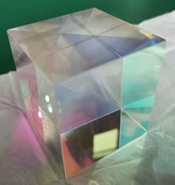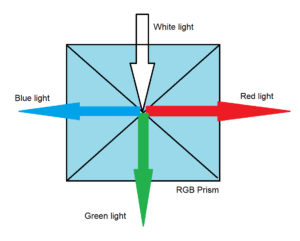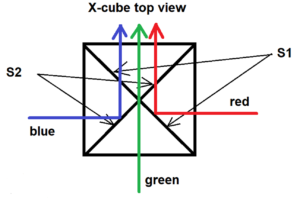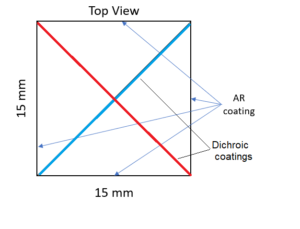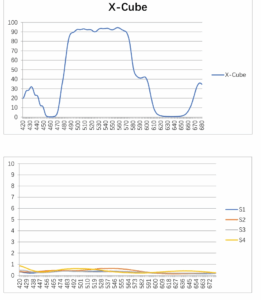RGB prisms
RGB prism are also related to as X-cubes, dichroic cubes, trichroic cubes, RGB combiners or even X-cube beamsplitter.
RGB prism definition
RGB prisms are optical elements that split the light into three elements : Red light, Green light and Blue light.
Natural visible light or white light is a continuum of light along the visible wavelengths, it can be separated in smaller signals centered around a specific wavelength (color).
It can also be used the other way round, concatenating different incident signals (Red, Blue and Green) into a white light output, it is then called X-cube combiner.
RGB prisms are usually polarization insensitive.
Bellow two figures are explaining schemes on how both usages are working.
Fig 1: X-cube beamsplitter scheme
Fig 2: RGB combiner scheme
Manufacturing
X cubes are usually manufactured in optical glass (commonly N-BK7 / H-K9L). Four isometric prisms are made with their faces optically polished. Thin layers dichroic filtering are coated on their inside faces. Using optically neutral glue the four prisms are then assembled together to form a cube. External surface are usually subject to Anti-reflect coating to lower optical losses.
Standard dimensions are between 4mm and 50 mm. For high-end X-cubes, manufacturing tolerances are +/-0.1mm with surface quality of S&D 40/20 and transmission above 92%.
Performances
As can be seen below due to high quality multi-layer coating, X-cubes show good optical performances with high transmission rate (more than 90% on the visible) and low reflection on the four surfaces.
What are the common usages ?
RGB prisms are sometimes used as a teaching tool in Physics class to show how white light can be split into 3 constituent colors.
Their more widely used in the industry as optical components in below devices :
- Projectors (LCoS & DLP)
- Cameras
- Displays
- Spectrometers
AR glasses (Augmented Reality) are a growing market for small X-cubes (mostly 4mm)
How to buy RGB prisms ?
X-cubes can either be standards parts and therefore bought directly from main optical components resellers or custom made. For custom made prisms it is important to have detailed specifications :
- Dimensions
- Transmission
- Detail of the input signal(s)
- Type of RGB prism (combiner or splitter)
- batch order quantities

